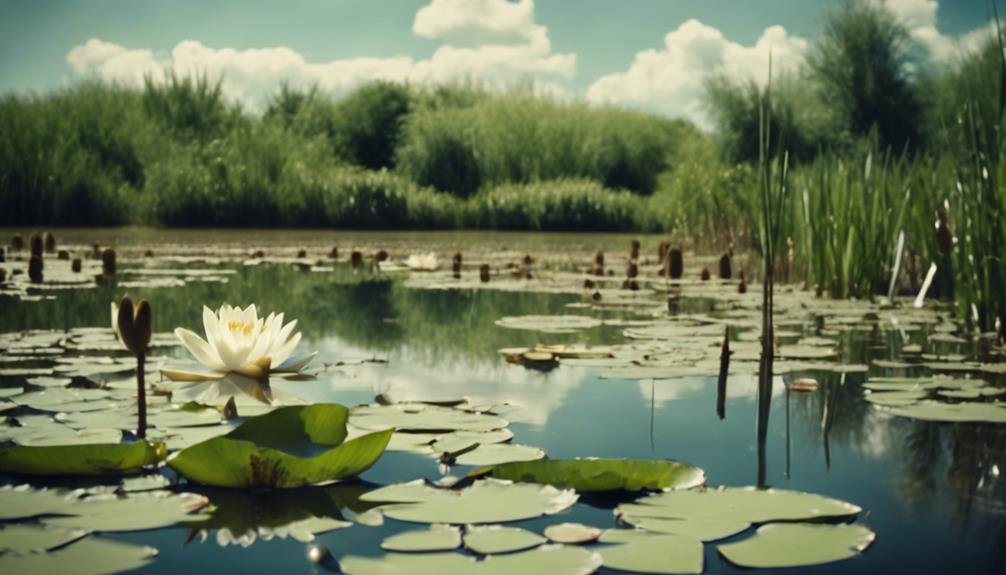You can effectively reduce pond nitrates naturally by maintaining a balanced ecosystem, introducing nitrate-absorbing plants, and beneficial bacteria that target and remove excess nitrates from the water. Plants like watercress and irises absorb nitrates, while beneficial bacteria convert ammonia into harmless nitrates. Regular water changes, a balanced fish population, and minimizing waste and sludge also help prevent nitrate buildup. By understanding the nitrogen cycle and incorporating these natural methods, you'll be well on your way to a healthy, thriving pond ecosystem. Now, take a closer look at the specific strategies that will help you achieve superior water quality.
Table of Contents
Key Takeaways
- Maintain a balanced fish population and avoid overfeeding to reduce fish waste and excess food decay, which contribute to nitrate buildup.
- Incorporate plant nitrate absorbers, such as watercress and irises, which can remove up to 90% of nitrates from the water.
- Introduce beneficial bacteria, like those in Envii Nitrate Klear, which target and remove nitrates and nitrites from ponds, supporting a healthy nitrogen cycle.
- Regularly test water for nitrate levels and perform partial water changes (20-50% every few days) to remove excess nutrients and prevent buildup.
- Implement natural waste and sludge reduction methods, such as sludge treatment, to break down decaying organic matter and reduce nitrate-producing substances.
Understanding Nitrate Buildup
Understanding that high nitrate levels in your pond can have devastating consequences is vital. You need to know that nitrates are a natural by-product of the breakdown of ammonia and nitrites in a pond environment.
While a low level of nitrates is safe, high levels can be harmful to fish and lead to algae build-up, blanket weed, and green water.
The nitrogen cycle, a natural process in ponds, contributes to nitrate buildup. Nitrosomonas bacteria convert ammonia into nitrites, and Nitrobacter bacteria convert nitrites into nitrates, a compound of nitrogen and oxygen.
However, fish introduce excess nitrogen into the pond system, leading to high nitrate levels. Overstocking, over-feeding, and crowding can exacerbate the issue.
To prevent this, maintaining a balanced fish population is vital, with 1-inch fish per square foot of pond space and 1 Koi fish per 1892 liters of pond water. By understanding the sources of nitrate buildup, you can take the first step towards maintaining a healthy and thriving pond ecosystem.
Natural Nitrate Removal Methods
As you explore natural nitrate removal methods, you'll find that incorporating plant nitrate absorbers and beneficial bacteria boosters can be effective strategies.
These approaches work in tandem to reduce nitrate levels, promoting a healthier pond ecosystem.
Plant Nitrate Absorbers
You can harness the natural nitrate-absorbing capabilities of certain aquatic plants to rapidly reduce nitrate levels in your pond.
Pond plants like watercress, irises, water lettuce, and water lilies are effective nitrate absorbers, capable of removing up to 90% of nitrates from the water.
These plants absorb nitrates as nutrients, reducing water pollution and maintaining a healthy ecosystem.
By incorporating these plants into your pond, you can create a balanced ecosystem that works together to maintain healthy nitrate levels.
For example, plants like irises and water lilies not only absorb nitrates but also provide shade, improve water circulation, and create habitats for beneficial insects and microorganisms.
Rapidly-growing plants like water lettuce and water hyacinth require extra care to prevent pond overgrowth, but can be highly effective at reducing nitrate levels.
Beneficial Bacteria Boost
By harnessing the power of beneficial bacteria, pond owners can create a natural nitrate removal system that maintains ideal water quality and supports a thriving aquatic ecosystem.
One effective way to do this is by introducing beneficial bacteria through products like Envii Nitrate Klear. This natural solution targets and removes nitrates and nitrites from ponds, even in cold water as low as 8°C.
By boosting beneficial bacteria populations, you can create a natural balance that reduces nitrate levels and promotes a healthy ecosystem for fish and other aquatic life.
Beneficial bacteria play a vital role in the nitrogen cycle, converting ammonia into nitrites and then into harmless nitrates, which can be absorbed by plants or removed through water changes.
Regular water tests can help you monitor nitrate levels and identify when beneficial bacteria treatments are needed to maintain ideal pond water quality.
The Role of Pond Plants

As you explore the role of pond plants in reducing nitrates, you'll discover how they absorb these nutrients through their leaves and roots, effectively filtering the water.
You'll learn how plants like water lettuce and water lilies can oxygenate the water, improving overall water quality.
Plant Uptake of Nitrates
Pond plants, such as watercress, irises, water lettuce, and water lilies, play a crucial role in nitrate reduction by rapidly absorbing these pollutants as essential nutrients for their growth.
As you introduce these plants into your pond, you're providing a natural, non-invasive method for nitrate reduction. By doing so, you're contributing to a balanced ecosystem where plants and koi coexist harmoniously.
To maximize plant uptake of nitrates, consider the following:
Provide favorable growing conditions, such as adequate sunlight, nutrients, and water circulation, to increase the rate of nitrate uptake.
Regularly prune your plants to prevent overgrowth and maintain a balanced ecosystem.
Guarantee a balanced ratio of plants to koi, as an overabundance of plants can lead to an imbalance in the ecosystem.
Natural Filtration Systems
Your pond's natural filtration system relies heavily on the presence of nitrate-removing plants, which serve as a crucial line of defense against water pollution.
These plants are incredibly effective at absorbing excess nitrates from the water, reducing the risk of algae blooms and maintaining a healthy environment for aquatic life.
By incorporating a variety of nitrate-removing plants into your pond, you can maintain nitrate levels below 5 ppm, creating a thriving ecosystem.
Rapidly-growing plants like watercress and water lettuce can reduce nitrate levels by up to 90% in just a few weeks.
Other plants, such as water wisteria and anacharis, can absorb up to 20-30 mg/L of nitrate from the water per day, making them effective natural filtration systems.
A balanced ecosystem with plants and koi helps maintain healthy nitrate levels, as plants provide a natural, non-invasive method for nitrate reduction.
Oxygenating the Water
By releasing oxygen into the water as a byproduct of photosynthesis, plants like watercress, irises, and water lilies play a crucial role in maintaining excellent water quality and supporting the health of aquatic life.
As you incorporate these plants into your pond, you'll notice a significant improvement in the overall ecosystem. The oxygen produced by these plants not only benefits the aquatic life but also helps to break down excess nutrients, including nitrates.
Rapid nitrate reduction: Plants absorb nitrates as nutrients, improving water quality and supporting a healthy ecosystem.
Improved water quality: Oxygen-rich water promotes a balanced ecosystem, where aquatic life thrives.
Natural and non-invasive: Plants are a natural and sustainable way to reduce nitrate levels, without using harsh chemicals or invasive methods.
Maintaining Healthy Water Balance
Maintaining a delicate balance of nutrients and waste is essential for preventing nitrate accumulation and promoting a thriving ecosystem.
As a pond owner, you play a vital role in achieving this balance. One effective way to do this is by performing regular water changes.
By replacing a portion of your pond's water with fresh, nitrate-free water, you're removing excess nutrients that can contribute to nitrate buildup. This helps to restore a healthy balance of nitrates in your pond, creating a thriving environment for your aquatic life.
Additionally, a balanced ecosystem with plants, koi, and regular water changes will maintain healthy nitrate levels and support the well-being of your aquatic life.
By taking these steps, you'll be able to enjoy a healthy pond with minimal nitrate-related issues.
Reducing Waste and Sludge

As you work to maintain a healthy water balance, it's equally important to address the issue of waste and sludge accumulation, which can substantially contribute to nitrate buildup in your pond. Excess food and decaying organic matter are common culprits behind waste and sludge accumulation, leading to higher nitrate levels.
To combat this, you can take several steps.
Regularly clean the pond floor and remove decaying organic matter to prevent it from breaking down and contributing to nitrate levels.
Maintain a healthy balance of beneficial bacteria in the pond, which helps break down waste and sludge, reducing the accumulation of nitrate-producing substances.
Consider using a sludge treatment, such as Blagdon Sludge Buster, to consume dead algae and organic sludge, further reducing waste and sludge in the pond.
Regular Water Testing and Monitoring
Regular water testing becomes a vital component of your pond's maintenance routine, empowering you to track nitrate levels and respond promptly to any fluctuations that could threaten the health of your aquatic ecosystem.
By regularly monitoring nitrate levels, you can maintain them below 50 parts per million, preventing harm to your koi and other aquatic life.
Using nitrate test strips or kits, you can easily and conveniently monitor nitrate levels in your pond.
Regular testing enables you to identify potential causes of high nitrate levels, such as overcrowding or overfeeding, and take corrective action.
By staying on top of nitrate levels, you can take proactive steps to maintain a healthy ecosystem and prevent nitrate-related issues.
Regular water testing and monitoring also allow you to address potential issues before they escalate and cause water pollution or harm to your aquatic life.
Preventing Nitrate Accumulation

By controlling the factors that contribute to nitrate buildup, you can prevent nitrate accumulation and create a healthier environment for your aquatic life.
Nitrates in your pond can lead to devastating consequences, but taking proactive steps can mitigate this issue.
To prevent nitrate accumulation, consider the following:
- Maintain a balanced fish population, with a general rule of one inch of fish per square foot of pond space. This reduces fish waste and excess food decay.
- Introduce nitrate-absorbing plants like watercress, irises, water lettuce, and water lilies, which can rapidly reduce nitrate levels in the pond.
- Avoid overfeeding and remove excess food to prevent decay and reduce nitrate accumulation in the pond.
Effective Maintenance Strategies
You can take your nitrate prevention efforts to the next level by implementing effective maintenance strategies that target and remove excess nitrates in your pond.
Regular water changes of 20-50% every few days can safely remove excess nitrates and help restore a healthy balance in the pond. This proactive approach prevents High Nitrate levels from harming your aquatic life.
Introducing beneficial bacteria through products like Envii Nitrate Klear can also target and remove nitrates, improving overall water quality and fish health.
Maintaining a balanced ecosystem with plants, koi, and regular water changes can help prevent nitrate buildup and maintain healthy nitrate levels below 50 parts per million.
By keeping your pond water clean and clear, you physically reduce nitrate levels, and regular testing enables prompt action to address nitrate issues before they harm your aquatic life.
Frequently Asked Questions
How to Reduce Nitrite in Pond Naturally?
You can reduce nitrite in your pond naturally by introducing beneficial bacteria, performing regular water changes, and optimizing pond aeration and water circulation to break down nitrite into harmless compounds, creating a healthy environment for your fish.
What Naturally Removes Nitrates From Water?
You can rely on water plants like watercress and irises to absorb nitrates, preventing algae blooms, while also utilizing beneficial bacteria to target and break down excess nitrates, effectively removing them from the water.
How Do I Bring the Nitrates Down in My Pond?
You're stuck with a nitrate-ridden pond, but don't let algae blooms take over! Regular pond maintenance, like water changes and plant care, can bring those levels down; Envii Nitrate Klear and beneficial bacteria can also lend a helping hand.
What Is the Fastest Way to Reduce Nitrates?
You're facing an emergency, and rapid testing reveals high nitrate levels. In this crisis, you need the fastest way to reduce nitrates. Try Envii Nitrate Klear, which quickly introduces beneficial bacteria to remove excess nitrates, even in cold water.
Conclusion
As you gaze out at your pond's serene surface, imagine the intricate ecosystem thriving beneath.
By embracing natural nitrate reduction methods, you're not only ensuring a healthy habitat for aquatic life, but also preventing the murky waters of nitrate buildup.
With a balanced pond ecosystem, you'll witness the vibrant dance of plants and microorganisms working in harmony, keeping nitrates in check.
By staying vigilant and proactive, you'll be rewarded with a crystal-clear pond that sparkles like a gem in the sunlight.

